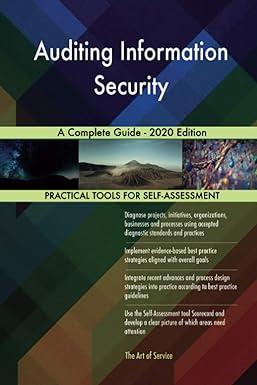Question
Edward is considering starting a business. The processing equipment costs are estimated at $245,000 and the building at $100,000. He estimates his working capital needs
Edward is considering starting a business. The processing equipment costs are estimated at $245,000 and the building at $100,000. He estimates his working capital needs at $20,000. Edward thinks that he would like to run the business for 10 years and then do something else. Here are the details of his operating costs:
1.He estimates the revenue for the first year will be $220,000 with an increase of 5% per year for the 10-year project life.
2.Returns on products by customers are estimated at 7% of revenues for all years.
3.Cost of goods sold (COGS), which is the total of all operating expenses to make the product, are estimated as 35% of the revenues.
4.Edward believes that the business will be started in the month of January and can be sold at the end of 10 years.
a. The equipment will be depreciated on a MACRS basis as a seven-year property.
b. The building will be depreciated as real property.
c. Assume the business will start in the January and sold in December.
d. Working capital will be recovered as part of the price that Edward will get for the business.
5.Edward estimates his selling and administrative expenses:
a. Selling expenses will be 10% of revenue in Year 1, increasing by 0.1% every year. This means that the Year 2 selling expenses will be 10.1% of that years revenue, the Year 3 selling expenses will be 10.2% of that years revenue, and so on.
b. Administrative expenses will be 2% of revenue in Year 1, increasing by 0.5% every year. This means that the Year 2 administrative expenses will be 2.5% of that years revenue, the Year 3 selling expenses will be 3.0% of that years revenue, and so on.
c. Research expenses will be $24,000 in the first year and will increase by 5% every year.
d. Marketing expenses will be 5% of revenue in Year 1, increasing by 0.5% every year. This means that Year 2 marketing expenses will be 5.5% of that years revenue, Year 3 marketing expenses will be 6.0% of that years revenue, and so on.
6.Income taxes can be assumed to be a flat 28% for all income levels.
7.Edward will draw a suitable salary for working for the company that is included in the COGS.
Based on the above scenario, complete the following exercises:
Exercise 9.4: If Edward finds that his product qualifies for an investment credit of 25% of his project cost (equipment, building, and working capital) in the original scenario, which he can claim as income at the end of the first year for which he will have to pay taxes at the regular rate in the first year:
a. What will be the IRR for the project?
b. What will be the NPV for his investment if the MARR was 11%?
c. What will be the EUAB that the business will be able to generate over the 10-year period?
Step by Step Solution
There are 3 Steps involved in it
Step: 1

Get Instant Access to Expert-Tailored Solutions
See step-by-step solutions with expert insights and AI powered tools for academic success
Step: 2

Step: 3

Ace Your Homework with AI
Get the answers you need in no time with our AI-driven, step-by-step assistance
Get Started


